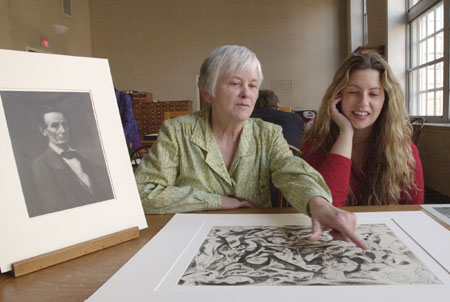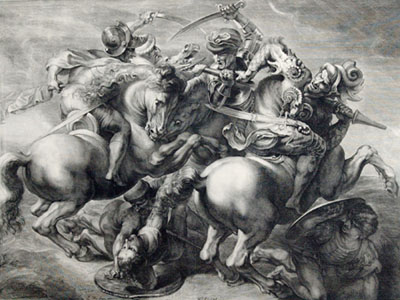Leaving an impression
Cohn introduces students to ‘the elegant realm of the repeatable image’

Ask yourself why paper currency is still engraved, and you will stumble into the exacting and elegant realm of the repeatable image. The query will take you back at least 150 years, to a time when engraving was an immensely popular printmaking technique. So much so, in fact, that in the 19th century the term “engraving” was used to describe any reproductive print. Of course the invention of photography nearly wiped it out, but there was a time when the technique was so highly regarded that a Civil War engraving of Abraham Lincoln done after a Matthew Brady photograph was far more valuable than the original. Today, engraving is still used to print money because it is hard to counterfeit, and because it carries intrinsic prestige.
Engraving refers to the process of incising a design on a hard surface of metal or wood, as well as the print that is made when that surface is inked and the image is transferred onto paper. It is traditionally associated with art prints or book illustrations. But it can also be found on paper currency, stock certificates, silver bowls, sundials and surveying instruments, and guns.
Marjorie Cohn, who teaches a seminar on engraving at the Mongan Center for Prints, Drawings, and Photographs, encourages students to seek out all of these objects in their exploratory study of the technique. In her course, which covers the history of engraving from the 15th to the 20th century and its place within the larger realm of the repeatable image, students indulge in the material collections of the Mongan Center, venture out to the art world to borrow or acquire supplementary objects, and cap off the semester by curating their own exhibit at the Fogg Museum.
Cohn, who is the Carl A. Weyerhaeuser Curator of Prints – and “Jerry” to students and colleagues, has been working in this area ever since her days as a graduate student in art history. She is a longtime scholar and historian of print techniques, a paper conservator, an amateur collector and printmaker – and above all, a lover of prints.

Nenita Elphick, now a fourth-year graduate student in the history of art and architecture, says, “Jerry is simply wonderful as a teacher. … Yesterday I dropped by the Mongan Center to look at a print and she came out to show me some woodblocks she had cut, a wood engraving I had been asking about, and some engraved stock certificates that our class had ordered from the Web, which had just arrived. Every week we go through at least 30 prints from the collection, which is a lot considering that before I took this class I had probably only seen about 50 prints over the course of my four years at Harvard.”
Indeed, as she discusses the shape of her course, Cohn holds up a Claude Mellan engraving, “The Assumption of St. Paul” (1674), in which she points out the rejection of outline in favor of a tonally modeled figure. She stands before the wooden worktable, and pulls out a magnifying lens attached to her key chain. “During the 17th and 18th centuries you see a growing modulation of line, a self-conscious variety of stroke. The question in this engraving is: Is the artist true to it as a technique, or is it used to imitate painting?”
Engraving, according to Cohn, lends itself to a swelling and contracting line, and to clean edges. “Remember that what you see in an engraving print is not what the artist handled; that is the engraved metal plate, and this paper is only derivative.” Most printmakers, however, delight in the moment when they pull a print and see the outcome. Cohn recognizes that deferral of pleasure, just as she recognizes virtuoso engravers who show off their talent by leaving a white line in an area of black. It was very difficult to do this – nearly impossible, in fact – because if the artist’s tool slipped and made an incision, the black line could not be erased easily.
The students in the class were able to experience this for themselves, with a copper plate and a burin, the tool of engravers. “It was fascinating to see all the different methods of cutting off the burr, that tiny curl of metal that sticks out after you have engraved a line with a burin,” says Maya Benton, a student in the arts in education program at the Graduate School of Education, who is also enrolled in the seminar.
“I was trying to make a circle. It was impossible. Then you see works in the Mongan Center by masters like Durer, and it makes you wonder how it is possible.”
Benton is balancing work in art history and education because she is interested in working as a curator in the visually rich and didactic setting of a Jewish art museum. She said the class caught her eye because she expects to someday work with Jewish print culture, which was extensive during the medieval and Renaissance periods. While she has curated exhibits in the past – including one on ancient Egyptian pottery at Brown University – Benton said she found it daunting to work with black-and-white works on paper, which are not as enticing to viewers as, say, turquoise.
The engraving seminar will be designing an exhibit to open in August at the Fogg. While the students may not be on campus, they will have made all of the decisions before they leave. Cohn hands them an empty plan of the gallery, and they designate theme and content, determine the placement of individual pieces, anticipate the appropriate color of wall paint, and write the label copy.
“I find that at the beginning, students are quite incapable of writing two paragraphs worth of something worth knowing, and translating what their eyes and mind perceive into label copy,” Cohn laments. She also struggles with another handicap: “I know the collection we own, they don’t, and that is a problem in knowing what to exhibit.” Nonetheless, she tries to turn the project over to her students. In previous years, when they did not find what they needed in the Fogg collections, she and her students have gone print-shopping in New York, visiting both Park Avenue galleries and tourist souvenir shops.
At the moment, the class plans to use a foyer space in front of the Lehman Gallery to draw viewers in with wonderful engravings from the Fogg collection.
“Jerry is very warm. She is not insisting that we have to create a big narrative with the exhibit, and so the message can simply be engraving,” Benton says.




